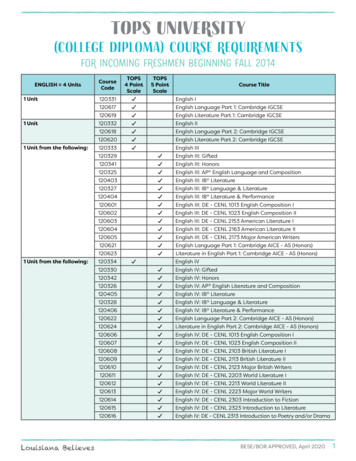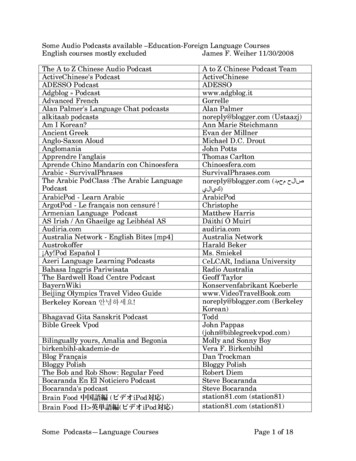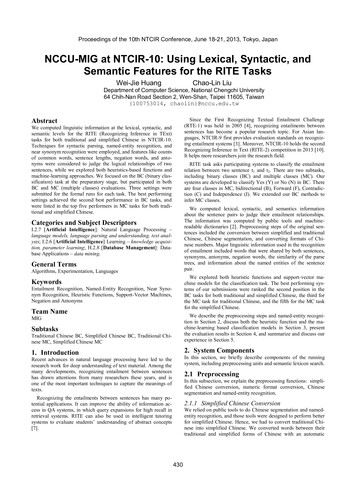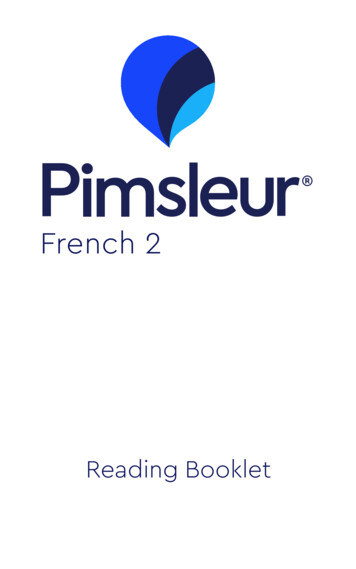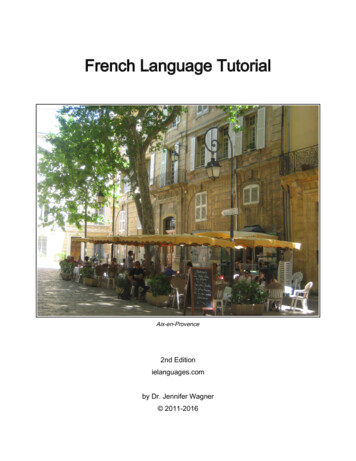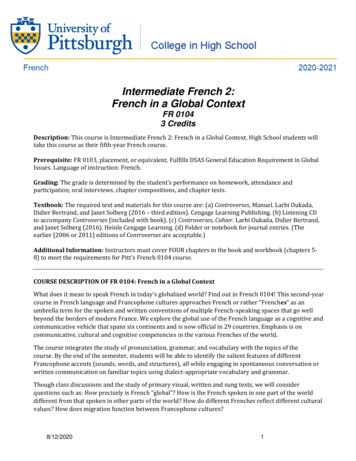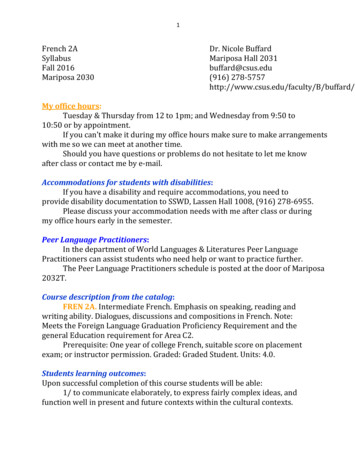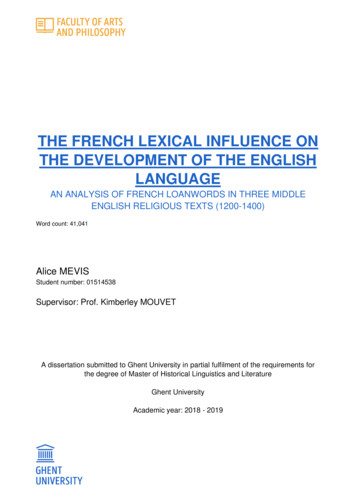
Transcription
THE FRENCH LEXICAL INFLUENCE ONTHE DEVELOPMENT OF THE ENGLISHLANGUAGEAN ANALYSIS OF FRENCH LOANWORDS IN THREE MIDDLEENGLISH RELIGIOUS TEXTS (1200-1400)Word count: 41,041Alice MEVISStudent number: 01514538Supervisor: Prof. Kimberley MOUVETA dissertation submitted to Ghent University in partial fulfilment of the requirements forthe degree of Master of Historical Linguistics and LiteratureGhent UniversityAcademic year: 2018 - 2019
Introduction . 4Theoretical background . 71.1.Theories on borrowing. 71.1.1.Definition of borrowing . 71.1.2.Lexical borrowing: typology . 91.2.The mechanics of lexical borrowing . 101.2.1.Lexical borrowing: a long-term process . 101.2.2.Motivations for lexical borrowing . 111.2.3.Changes in form and meaning . 131.3.Lexical borrowing in the history of English . 141.3.1.Early Latin loanwords . 141.3.1.1.Continental Latin borrowing of the pre-Christian era (1st-5th century) . 141.3.1.2.Pre-Christian insular borrowings (ca. 450-600). 151.3.1.3.Latin loanwords of the Christian era in the British Isles (from the 7th c.) . 151.3.2.Scandinavian lexical borrowing . 151.3.3.French lexical borrowing . 161.3.4.Differences between French and Scandinavian lexical borrowing . 181.3.5.From French native speakers to English bilinguals . 191.4.Conclusion. 20Aim, material & methodology . 21Semantic analysis . 273.1.Preliminary considerations: influence of the genre . 273.1.1.The homiletic tradition: between continuity and rupture . 273.1.2.Moral purpose and literary quality . 293.1.3.Conclusion . 303.2.Preliminary results . 323.3.Internal factors: filling a structural gap . 363.4.External factors: reconstructing lexical change against the social changes of the time . 433.4.1.Changes within the Church . 443.4.1.1.Pastoral care and mendicant orders . 443.4.1.2.Confession and the treatment of the sins . 463.4.1.3.Contemplation . 513.4.2.3.4.2.1.Changes in secular government . 58Changing social order . 592
3.5.3.4.2.2.Political change and the survival of old traditions: the military domain. 613.4.2.3.The imagery of the Norman court of justice in religious writings . 63Semantic evolution from the Ancrene Wisse to the Cloud. 683.5.1.From spoken to written French influence (“scholarship, science & arts”) . 683.5.2.From concrete to abstract terms (“psychological & mental processes”). 713.6.Conclusion on semantics. 74Lexical integration of French loanwords . 774.1.A closer look at the Ancrene Wisse . 784.2.Phonology and spelling . 794.3.Morphology: evolution from the Ancrene Wisse to the Cloud . 824.3.1.The Ancrene Wisse: laying the foundations for further integration . 824.3.2.Complex loanwords and derivational processes . 834.3.3.Hybrids and loanblends . 894.3.3.1.Hybrids with native base . 894.3.3.2.Hybrids with a foreign base. 914.4.Syntactic elaboration in the Cloud of Unknowing . 994.5.Mutual influence supports integration. 1024.6.Conclusion on lexical integration . 106Conclusion . 108Bibliography . 110Appendix I: the Ancrene Wisse. 115Appendix II: the Northern Homily Cycle . 130Appendix III: the Cloud of Unknowing . 138Appendix IV: Database . 152Word count: 41 041 words3
IntroductionThe history of the English language is one of fascinating encounters between differentpeoples and cultures in the course of time. If one was to pinpoint one of the decisive sociohistorical events bringing about profound and enduring changes, however, the NormanConquest would be a suitable candidate. The Norman Conquest profoundly altered the Englishsociety and dramatically influenced its linguistic evolution. For nearly four centuries, Frenchtook over as the official language of the English nation, while the cultural outreach of the Frenchculture reinforced its hold on English throughout the Middle English period (ca. 1100-1500). Atrilingual society prevailed in England during the late Middle Ages, English, French and Latincoexisting in some sort of symbiotic relationship, “interpenetrating and drawing strength fromone another”, eventually shaping “one culture in three voices” (Lerer 2007: 55). Nowadays,however, the situation has reverted itself and English has come to occupy the place that Frenchhad steadily held throughout the Middle Ages. Because of this reversal of sociolinguisticsituation, the strong influence that French had once exerted on the English lexicon is no longerreadily noticeable, at least to the layman.This study aims at investigating that long-lasting influence of Old French on MiddleEnglish, more specifically its lexical influence, and situates itself in the theoretical frameworkof borrowing – lexical borrowing in particular – and of contact-induced language change.French influence on Middle English has drawn considerable attention among scholars andseveral attempts have been made at quantifying the French contribution to the English lexicon(Dekeyser 1986; Caluwé-Dor 1992; Nielsen 2005). In addition, the entrance into the lexis ofMiddle English of a large number of French loanwords did not only lead to a profoundrestructuring of the lexicon, but also deeply affected the English morphology and patterns ofderivation (Kastovsky 1994), as well as the English syntax to some extent (Smith 2012;Haeberli 2010). However, although those changes have been acknowledged as decisive for theevolution of the English language, the aim of this paper is not to stress the disruptive influenceof French, but rather to examine the lexical borrowing from French as part of a natural processof linguistic evolution and the degree to which the new vocabulary already integrated into theEnglish lexicon during the Middle English period. Rather than the rupture, we want to4
emphasise the continuity in the development of English and see how the foreign element hasbeen integrated in its internal linguistic system in the course of time.In order to undertake this analysis, three excerpts from religious texts have been selected asstarting point. Those texts, spread over the Middle English period, are more likely to bearwitness to the continuity of English writings since they are said to be part of a long and wellestablished English tradition of composition in the vernacular which finds its roots in the OldEnglish period (Chambers 1957: lxxvi). Our objective is not so much a quantitative as aqualitative approach. After having identified the presence of French lexical items in ourexcerpts, a qualitative and in-depth analysis of the words of our corpus will be carried out: wewill first have a look at the type of words that are concerned, the semantics and connotationsassociated with those words and the reasons why they are used in such contexts. In a secondstep, we will describe how they have changed (or not) overtime, and the patterns or processesthat they have followed. By doing this, we hope to come to conclusions regarding the extent ofthe integration and the degree of nativisation of the French loanwords in Middle English, bothfrom a morphosyntactic and content perspective, as well as to unveil the mechanics at playbehind the French lexical borrowing in the Middle English period as reflected in religious texts.We also want to see if a consistent pattern of evolution can be discerned.This paper is divided into two parts: Chapter 1 and 2 cover the theoretical backgroundnecessary to undertake a proper analysis of loanwords. Chapter 1 contains a brief descriptionof the mechanics of lexical borrowing as well as an overview of language contact in the historyof English. The aims, material and methods are laid out in Chapter 2. The second part – the coreof our study – is concerned with the corpus analysis. Chapter 3 discusses the semanticsassociated with the loanwords and aims at uncovering tendencies for the adoption of particularloanwords with respect to their semantic content. Chapter 4 explores the extent of theintegration of the loanwords under examination into the lexis of English. Finally, this paperconcludes by highlighting important findings and pointing towards possibilities for futureresearch.5
PART 1:theoretical background& methodology6
Theoretical background1.1. Theories on borrowing1.1.1. Definition of borrowingIn his Oxford Guide to Etymology, Philip Durkin gives the following definition ofborrowing: “borrowing is the usual term for the process by which a language takes newlinguistic material from another language. [ ] Borrowing occurs in situations of languagecontact and is indeed an almost inevitable consequence of it, although the levels and types ofborrowings which are found differ greatly in different types of contact situations” (Durkin 2009:132). From that definition, several interesting points stand out for the research presented in thispaper (1.1-1.4).(1.1)A situation of language contact can be of different types (influence of substratum,superstratum or adstratum; geographical, social or literary contacts). It is important todefine the type of language contact and its implications for the type of borrowing.(1.2)When speaking of “languages in contact”, what it usually referred to is a situation ofusers of language in contact. The role of bilingual speakers, high officials and learnedpeople is of particular relevance with respect to borrowing. Borrowing involve mostoften some degree of either mutual intelligibility or bilingualism (Durkin 2009: 156).(1.3)Just as there are different types of contact situations, there are different types ofborrowing. One refers in general to either lexical or grammatical borrowing: not onlywords might be borrowed from another language, but also morphemes, phonemes andeven syntactic features.7
(1.4)There can be different levels of borrowing; foreign elements might be more or lessintegrated into the system of the receiving language. This implies some internalconditions for the acceptance of foreign characteristics, a certain proneness of thelinguistic system to adopt particular features of the donor language.From the definition presented above, it appears rather clearly that borrowing involves“externally-motivated changes” (Campbell 1989: 91), resulting first from a situation oflanguage contact and further determined by the duration of the contact situation, the status heldby the donor language and the intensity of the relations between the different linguistic groups.But the part played by internal, intralinguistic factors should not be overlooked. Even if hefocused on grammatical borrowing in his essay, Campbell explored the so-called “structuralcompatibility requirement” which claims that borrowing is only possible between very similarlinguistic systems, such as dialects of the same language. This is a claim held by severallinguists, the first being Jackobson: “a language accepts foreign structural elements only whenthey correspond to its tendencies of development.” (Jakobson 1938: 54, cited by Weinreich1953: 25, in Campbell 1989: 92). Weinreich also suggested that “such latent internal tendenciesexist even without the intervention of foreign influence; the language contact and the resultinginterference could be considered to have, at best, a trigger effect, releasing or acceleratingdevelopments which mature independently”. Campbell nevertheless demonstrated thatborrowing did not happen only in situations of shared structural similarity and that social factorsmight overcome structural resistance to borrowing (Campbell 1989: 94). In addition, lexicalborrowing is less constrained that grammatical borrowing, so that lexical items are more easilyborrowed than grammatical structures (Campbell 1989: 101). The structural-compatibilityprinciple should thus be considered as a general tendency rather than an absolute constraint(Campbell 1989: 104). However, differences between the grammatical systems of any twolanguages may well have a significant impact on borrowing, because borrowing is in generaleasier between closely related languages or between languages presenting some degree ofmutual intelligibility (Durkin 2009: 164). If borrowing is mainly triggered by external factors,internal factors within the linguistic system will have a crucial role to play in the scope of theborrowing and the extent to which the new elements will integrate and make their way into theborrowing language.8
1.1.2. Lexical borrowing: typologyThe type of borrowing that we are interested in in this paper is lexical borrowing. The lexisof a language is subject to two kinds of change: changes due to internal developments and wordformation processes inherent to the lexicon such as derivation, compounding, back-formationand conversion; and changes brought about by the external influence of another language(Aertsen 1989: 25-26). Lexical borrowing falls within this latter type of change. However, evenif lexical borrowing is triggered by external influence and sociolinguistic factors, it is alsomotivated by internal factors such as morphological analogy and functional utility (Nielsen1998: 82). The very act of borrowing is an act of inherent complexity and it is sometimesdifficult to assess the share of external and internal factors in the process. Some attention willalso be devoted to derivational processes in Chapter 4, but only as a secondary step resulting ofthe assimilation and naturalisation of foreign loanwords. Four different types of lexicalborrowing are generally distinguished (1.5-1.8):(1.5)Loanwords: this is the more general type of borrowing, when a word, its form and itsmeaning is transferred from the donor language into the borrowing language. Theremight be some degree of assimilation to the sound system as well as to the inflectionalmorphology of the borrowing language (e.g.: verb inflections or plural form).Loanwords show differing degrees of naturalisation from a phonological, prosodic ormorphological point of view, which are often related with the date of entry into thelexicon (e.g. oblige vs. prestige: difference in vowel quality; syllable vs. campaign:difference in pattern of accentuation; appendixes or appendices: difference inmorphological pattern). These will be the main focus of our study.(1.6)Loan translations (or calques) are the replication of the structure of a foreign-languageword or expression by means of synonymous word forms in the borrowing language.However, there is not always an exact correspondence between the words or expressionsin either language. This was one of the preferred methods of Old English: instead ofusing Latin loanwords as such, Old English “translated” them by means of native words(e.g. Evangelium, ‘good tidings’, became godspell in English).9
(1.7)Semantic loans: this was also a method frequently used by Old English. It consists intaking an existing word and extending its meaning to integrate or denote new concepts.(e.g. Easter, the name of the dawn Goddess, was eventually used to express a Christiancelebration). In the case of a semantic loan, a word of the donor language influences thedevelopment of a word in the borrowing language, but only from a semantic point ofview (it has little to no influence on its form).(1.8)Loanblends (and hybrids): this category is considered by some scholars as anintermediate category between loanwords and loan translations (Durkin 2009: 138). Itconsists of the borrowing of a complex word where morphs in the borrowed word arereplaced by native morphs (e.g. ofservet in the Ancrene Wisse). A loanblend is differentfrom a hybrid in that the latter is a complex word deliberately built from elements witha different etymology through processes of derivation (e.g. spushad or covershipe in theAncrene Wisse). As such, hybrids are considered by scholars as instances of indirectborrowing (Dekeyser 1986: 254) Hybrids and loanblends will be discussed in Chapter4, section 4.3.3. of this study.1.2.The mechanics of lexical borrowing1.2.1. Lexical borrowing: a long-term processThe study of lexical borrowing is closely interconnected with cultural history andextralinguistic factors (Durkin 2009: 149), but we have seen that internal processes are alsolikely to play a part, although they are often secondary to and might be overcome by socialfactors. In addition, once a word has been borrowed, it has to spread further into the lexicon:“initial interlinguistic borrowing is typically followed by intralinguistic borrowing” (Durkin:178). It is not because a loanword appears in the text of one specific author that it willautomatically be used (and understood) by all other speakers of the language. We should thusbe careful with single instances of a word in a text. The choice of words in the Middle Ageswas largely idiosyncratic and often dependent on the choices of the author or the scribe (Bennett& Smithers 1968: 52). Internal or secondary borrowing can occur from one dialect to another,or from a very specific to a more general use (Durkin: 144) and is more reliant on internalfactors since the loanword will exhibit a greater morphosyntactic integration.10
It emerges from what has been said that borrowing is not a “once-and-for-all process”.Instead, the process of adoption and spread into the lexicon is a very gradual one (Durkin 2009:141-142). Full acceptance of a lexical item as the dominant expression can take centuries tooccur, if it ever does. Dance (2003: 311-313, cited in Durkin 2009: 163) further emphasises that“some lexical redundancy is natural within a system, as are other types of variation. [ ] Lexicalborrowing can be seen simply as adding to variation in the first instance, and not as a drasticimposition on the core of a language’s vocabulary that needs to be accounted for by tremendouspressures of prestige attaching to the source tongue”. Dance’s affirmation is in line with ourstandpoint which tends to see lexical borrowing from French as a natural process of evolutionresulting from situation of language contact, rather than a ‘counterintuitive’ or unnaturalimposition by the dominant group of speakers.1.2.2. Motivations for lexical borrowingSeveral factors are at play for the adoption of a particular word into the lexicon. Durkinidentifies “need and prestige” as two “traditional” motivations for lexical borrowing, but healso stresses the limitations of both concepts (2009: 142). Borrowing in order to fill semanticneeds typically happens when the borrowing language lacks a word to express a particularreality, or when new concepts arise that need to be given lexical expression. However, if it istrue that new concepts constantly appear in a given society, it would be exaggerated to assertthat borrowing was necessary to fill structural gaps of Old English.The hypothesis according to which Middle English would have borrowed heavily fromFrench because of lexical gaps or insufficiency is challenged by the fact that Old English wasvery reluctant to borrow new words from Latin and preferred to use its own resources such asloan translations or semantic loans (Nielsen 1998: 133). However, those native resourcesgradually fell into oblivion simultaneously with the well-established West-Saxon literarytradition, as a consequence of tremendous historical and political changes (i.e. the NormanConquest), whereas religious reforms and social changes, taking place both in England andthroughout Europe during the 12th and 13th centuries, triggered the need for new means ofexpression (see Chapter 3, section 3.4.).Lexical borrowing as a result of the so-called prestige of one language is not acomprehensive concept either, because it fails to account for the wide-ranging changes thatoccurred in the wake of the Conquest. Prestige is linked with stylistic choices: the author makesa conscious use of a foreign element into his language. Trotter refers to that type of loanwords11
as ‘cultural borrowings’. Dominance would be a more suitable term to account for a type oflexical borrowing that involves the language of a politically or socially dominant class (Durkin2009: 143). Lexical borrowing because of prestige involves awareness on the part of the author;dominance, on the other hand, leads to the gradual obliteration of native words because of therecurrence of words of the dominant language in a less conscious process. It mainly concernswords that have to do with the new social order established by the ruling class. Finally, Nielsen(2005: 104) and Trotter (2003: 91) identified a third type of loanwords, that resulting fromlinguistic coexistence. This category is mainly made up of everyday words, referred to as ‘coreborrowings’.Furthermore, the role of bilingual speakers should not be overlooked. For the scribal class,who operated in multilingual environments, Anglo-French and Latin were ever-presentlanguages of record providing readily available lexical resources. According to Trotter (2003:85), the traditional concepts of separate and separable languages owe possibly more to modernideologies than to contemporary perceptions of linguistic reality and should be revised. Indeed,although they occurred in a situation of diglossia, Trotter suggests that Latin, French andEnglish interpenetrated more intimately than our modern conceptions of language allow us tothink, and that scribes, as all multilinguals do, plainly drew on every language at their disposal.The first attestation of a word of French origin into a Middle English text could therefore onlybe an isolated instance of code-switching and does not necessarily lead to the assumption thatthe word has been accepted in the general lexicon of the language on a larger scale.Finally, the internal factor of morphological compatibility, if not considered as a motivation,will nonetheless facilitate the subsequent adoption of a word into the lexicon and ensure itsultimate fixation into the vocabulary (see Chapter 4, section 4.5.). The motivations for lexicalborrowing are thus various and complex and go beyond the conventional explanations ofpolitical dominance or cultural prestige. One should therefore remain careful and critical withtraditional motivations for fear of oversimplification of complex sociolinguistic situations(Timofeeva 2018a: 6).12
1.2.3. Changes in form and meaningOnce they have integrated into the lexis of a language, loanwords are subsequently subjectto change, both in form and meaning. The change in word form can give information about theprovenance of a word and be traced back thanks to historical grammar. However, acorresponding historical semantics does not exist that would help the scholars trace back thesemantic evolution of a word. Semantic changes are not easily predictable and depend heavilyon extralinguistic factors (Durkin 2009: 259-260). As such, two words of identical etymologycan develop in different ways in different languages. Our corpus presents much evidence ofwords borrowed from (Anglo-)French that have a similar (if not identical) form and meaningat that time, but that will overtime suffer a semantic evolution as well as changes in word formthat will differentiate them utterly from one another. The loanword charge, recorded in theAncrene Wisse and the Cloud of Unknowing, entered the vocabulary of Middle English with thesame meaning as its French counterpart, ‘to weigh’. Overtime though, it came to signify ‘toaccuse’. Modern English very was originally borrowed from Anglo-French verrey ‘true’ andevolved both in form and in meaning overtime, ultimately shifting from one word-class toanother.Changes also occur within the system itself. The process of analogy is very important inthis evolution and often occurs between words (native or borrowed) that present a similarphonological structure or share some of their meanings. Two processes of analogy are worthemphasising: analogy in meaning (1.9) or in word form (1.10).(1.9)We speak of semantic contamination when a word often occurs in a collocation withanother word, and subsequently takes up the connotation associated with that other wordto acquire in turn a more positive or negative meaning. This is the case of the wordknave, meaning ‘boy’ in Old English and which evolve to denote ‘one of low birth’ inMiddle English, then took up the negative sense of ‘rogue, rascal’ (Durkin 2009: 238).(1.10) We speak of formal contamination when some words are remodelled on the basis ofperceived formal parallels within the linguistic system. Such an analogical change isobservable in the integration of the French loan cacchen into the paradigm of the nativeirregular verb lacchen ‘to seize’ in Middle English, as well as the integration of Frenchstrive in the paradigm of drive. This process of analogy and mutual formal influencewill be strong in the adoption of some loanwords into the English lexis (Durkin 2009:201).13
1.3. Lexical borr
7 Theoretical background 1.1. Theories on borrowing 1.1.1. Definition of borrowing In his Oxford Guide to Etymology, Philip Durkin gives the following definition of borrowing: "borrowing is the usual term for the process by which a language takes new


